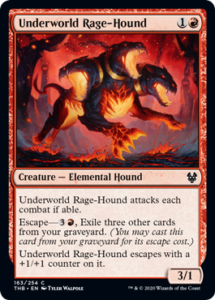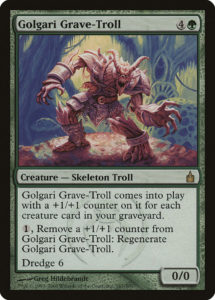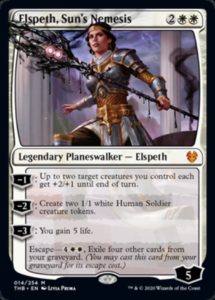Theros: Beyond Death features three returning mechanics—Devotion, Sagas, and Constellation. It also introduces one new mechanic called Escape. It’s a cool mish-mash of things we’ve seen before. Escape is a graveyard mechanic, something which has proven both popular and difficult to balance for both Constructed and Limited. Today we’ll explore what Escape is, where it came from, and how it’s likely to play.
Can’t keep them down
Escape is a recursion mechanic that allows you to repeatedly cast spells from your graveyard. It goes on permanents like Underworld Rage-Hound—who’s definitely a cerberus, which I guess is kind of a synonym for Rage-Hound? It can also appear on spells, always with the same effect (recasting the card). But as our new dog-friend can attest, some cards Escape with some extra oomph.
Escape also has two knobs for balancing: it requires both a mana investment and some number of cards to be exiled from your graveyard. These allow Play Design a good amount of flexibility to balance each card individually, making it easier to push some cards for Limited and others for Constructed. Compare that to Guilds of Ravnica’s Undergrowth mechanic, which struggled in part becausse of its lack of knobs to adjust.
Ancestry
Perhaps the most obvious precursor mechanic to Escape is Dredge. Both mechanics allow cards to repeatedly leave the graveyard. They both reward self-mill, they synergize with each other (Dredging makes it easy to pay Escape’s non-mana cost), and Escape even does Dredge one better by not making you skip a draw. However, while Dredge fuels itself by finding more Dredge cards (until you eventually deck yourself and die); Escape consumes its fuel, making it antisynergistic with other Escape cards (and itself). It’s reminiscent of Innistrad’s Skaab mechanic, where you could play undercosted creatures, but needed to feed them dead creatures first.
Perhaps the clearest ancestor is Retrace, the paradigm mechanic for repeatedly casting spells out of the graveyard (unlike Flashback and Unearth, which only work once). However, Escape has triple the knobs that Retrace does—Retracing always costs one land and the spell’s exact mana cost. This means the mechanic can work in a variety of ways. Oona’s Grace had to cost three mana because a two mana version would grant every land Cycling, but one can imagine an Escape cantrip that costs one mana, but whose Escape costs an exorbitant six cards or four mana (but not both).
It’s actually pretty exciting seeing all of the possibilities that Escape offers that Retrace and even Flashback couldn’t, because it has both a mana and graveyard cost. Of course, these extra costs also diminish the power of the mechanic, since they make it more expensive to use.
But how does it play?
There are all sorts of predictions about how Escape will play out, but we’ve a bit of empirical data to work with. The Game Awards After Party allowed Arena players to try out Elspeth, Sun’s Nemesis. Sure, she wasn’t part of a dedicated Escape deck (white doesn’t do self-mill), so her Escape involved playing Magic and letting your cards naturally hit the graveyard through combat and spellcasting. Elspeth seemed powerful, but not incredibly broken, and was fairly difficult to recast a second time. Absent much self-mill in Theros: Beyond Death, this will likely be how Escape plays out in Limited (especially in red and white).
Games generally need to go fairly long or players need to trade resources very aggressively for graveyards to fill up. This was a weakness Golgari’s opponents in Guilds of Ravnica draft could exploit, since keeping an opponent’s creature alive could proactively invalidate Rhizome Lurcher (the big common Undergrowth payoff).
Things should be a bit different now, given that Escape won’t be locked into a single guild that struggles to be played with other colors—combat should be more tense when both players regularly have access to Escape cards. Still, it’ll likely be difficult to Escape more than a small handful of times, even in a very long game—just thing about how difficult it can be to turn on Threshold. As spoiler season goes on, it’s worth examining how much support there is for self-mill in Limited, how many creatures have square stats or higher power than toughness (making them more likely to die and fuel Escape), and how much removal circumvents the graveyard (such as Banishing Light and Charmed Sleep)
In Constructed, the rules are quite different. If you want to fill your graveyard, you have ample tools. It’s all a question of what effects are put on Escape cards and how they’re costed. Elspeth and Underworld Rage-Hound have clear potential applications as attrition winners, but they require a nontrivial amount of cards and extra mana, restricting their ease of use outside of fairly long games.
I wouldn’t be surprised if several Escape cards buck this trend by relying on a premium of cards or mana (but not both). But honestly, all one can do is speculate at this point. There likely won’t be a Stone Rain or Cancel with Escape, but there could be a cool twist on Roar of the Wurm, Fireblast, even Basking Rootwalla. Time will tell. Until then, I’ll be coming up with my own Escape designs and seeing if the lessons learned there match the cards Wizards will soon spoil.
And, as always, thanks for reading.
—Zachary Barash is a New York City-based game designer and the commissioner of Team Draft League. He designs for Kingdom Death: Monster, has a Game Design MFA from the NYU Game Center, and does freelance game design. When the stars align, he streams Magic (but the stars align way less often than he’d like).




